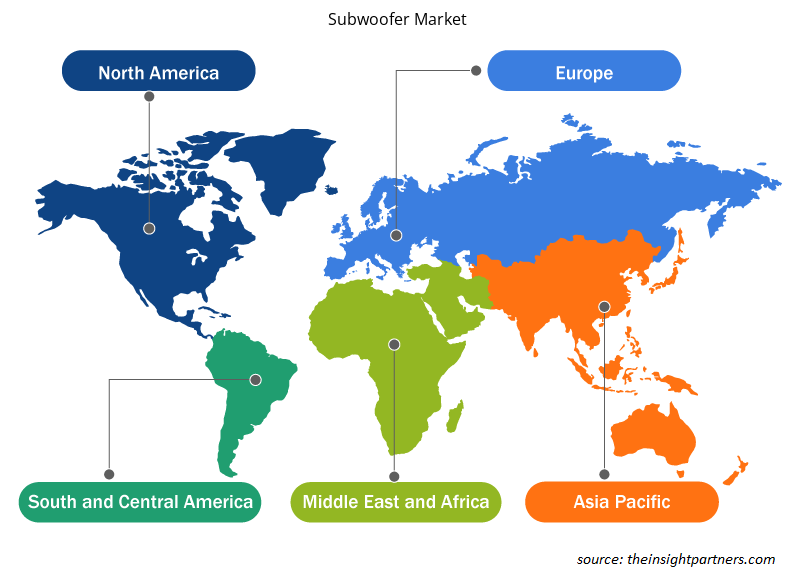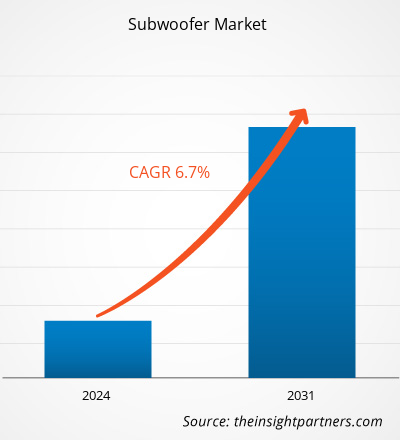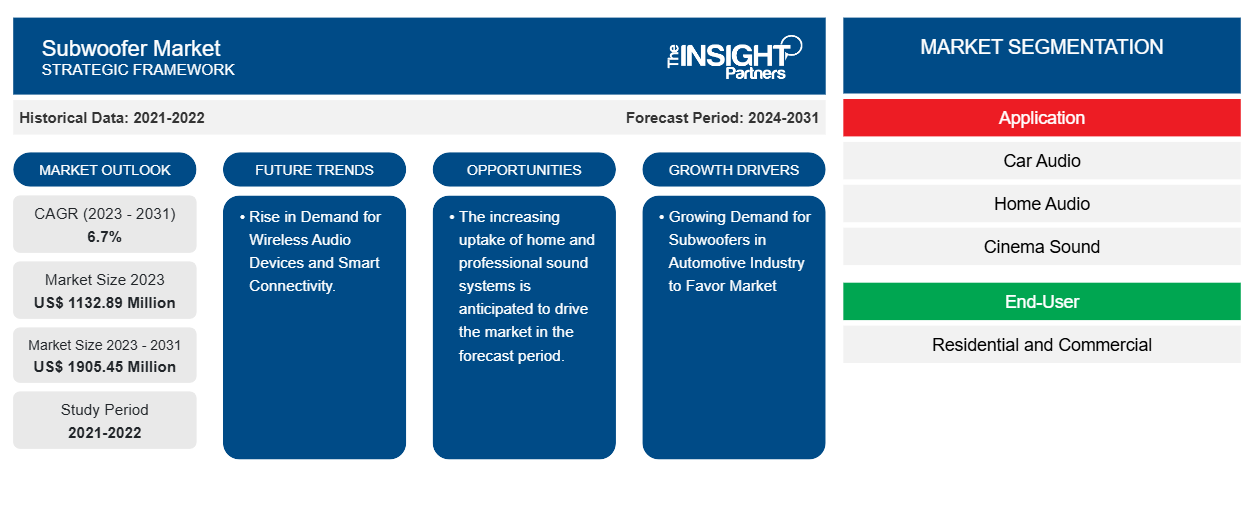Si prevede che la dimensione del mercato dei subwoofer raggiungerà i 1905,45 milioni di dollari entro il 2031, rispetto ai 1132,89 milioni di dollari del 2023. Si prevede che il mercato registrerà un CAGR del 6,7% nel periodo 2023-2031. La crescente domanda nel settore automobilistico e la crescente popolarità nelle applicazioni residenziali e nei cinema e teatri saranno probabilmente i principali motori e tendenze del mercato.
Analisi del mercato dei subwoofer
Il mercato dei subwoofer sta vivendo una crescita significativa a livello globale. Questa crescita è attribuita a fattori quali la crescente domanda nel settore automobilistico e la crescente popolarità nelle applicazioni residenziali domestiche e nei cinema e teatri. Inoltre, si prevede che l'aumento della domanda di dispositivi audio wireless e connettività intelligente e la crescente adozione di sistemi audio domestici e professionali offriranno diverse opportunità per il mercato dei subwoofer.
Panoramica del mercato dei subwoofer
Un subwoofer è un altro termine per un altoparlante, ed è dedicato alla riproduzione di quel battito pulsante a bassa frequenza e con bassi pesanti che puoi sentire nelle ossa in un club o durante una scena piena di azione al cinema. I suoni a bassa frequenza con l'aggiunta di un subwoofer includono canzoni con bassi pesanti, grancasse, un film rimbombante, effetti sonori TV e altro ancora.
Personalizza questo report in base alle tue esigenze
Riceverai la personalizzazione gratuita di qualsiasi report, comprese parti di questo report, o analisi a livello nazionale, pacchetto dati Excel, oltre a usufruire di grandi offerte e sconti per start-up e università
-
Scopri le principali tendenze di mercato in questo rapporto.Questo campione GRATUITO includerà analisi di dati che spaziano dalle tendenze di mercato alle stime e alle previsioni.
Driver e opportunità del mercato dei subwoofer
La crescente domanda di subwoofer nel settore automobilistico favorirà il mercato
Un subwoofer completa la mancanza di bassi dagli altoparlanti principali dell'auto. Il risultato è un'esperienza di ascolto più ricca, più vivace e più realistica. Ecco perché la riproduzione dei bassi è spesso molto migliore rispetto all'installazione originale del veicolo. La maggior parte degli altoparlanti stereo per auto inizia a calare a circa 50 Hz. Ma un subwoofer di qualità riprodurrà basse frequenze fino a 20 Hz o meno.
Inoltre, molte aziende offrono subwoofer per l'automotive. Ad esempio, HARMAN International Industries ha lanciato la nuova serie Infinity Reference, una collezione di subwoofer a montaggio superficiale. Con un buon design e progettati per fornire bassi potenti, i nuovi altoparlanti porteranno l'esperienza di ascolto in auto a un livello completamente nuovo.
Aumento della domanda di dispositivi audio wireless e connettività intelligente.
Si prevede che l'aumento della domanda di dispositivi audio wireless e connettività intelligente offra diverse opportunità per il mercato. I subwoofer che si integrano perfettamente con i sistemi audio wireless sono molto interessanti. Man mano che i consumatori investono in altoparlanti wireless e sistemi audio domestici, aumenta la domanda di subwoofer compatibili. Inoltre, aumenta il numero di aziende che forniscono dispositivi audio wireless. Aziende come Boat, zebronics, JBL, ecc.
Analisi della segmentazione del rapporto di mercato dei subwoofer
I segmenti chiave che hanno contribuito alla derivazione dell'analisi di mercato dei subwoofer sono l'applicazione e gli utenti finali.
- In base all'applicazione, il mercato dei subwoofer è suddiviso in car audio, home audio, cinema sound, sound reinforcement e altri. Si prevede che il segmento car audio detenga una quota di mercato significativa nel periodo di previsione.
- In base agli utenti finali, il mercato dei subwoofer è diviso in residenziale e commerciale. Si prevede che il segmento residenziale detenga una quota di mercato significativa nel periodo di previsione.
Analisi della quota di mercato dei subwoofer per area geografica
L'ambito geografico del rapporto sul mercato dei subwoofer è suddiviso principalmente in cinque regioni: Nord America, Asia Pacifico, Europa, Medio Oriente e Africa, Sud e Centro America.
Il Nord America ha dominato il mercato dei subwoofer. Le tendenze di adozione di tecnologie elevate in vari settori della regione nordamericana hanno alimentato la crescita del mercato dei subwoofer. Fattori come l'adozione crescente di strumenti digitali, l'elevata spesa tecnologica da parte delle agenzie governative, la crescente domanda nel settore automobilistico e la crescente popolarità nelle applicazioni residenziali e nei cinema e teatri dovrebbero guidare la crescita del mercato dei subwoofer del Nord America. Inoltre, una forte enfasi sulla ricerca e sviluppo nelle economie sviluppate degli Stati Uniti e del Canada sta costringendo i player del Nord America a portare sul mercato soluzioni tecnologicamente avanzate. Inoltre, gli Stati Uniti hanno un gran numero di player del mercato dei subwoofer che si sono concentrati sempre di più sullo sviluppo di soluzioni innovative. Tutti questi fattori contribuiscono alla crescita del mercato dei subwoofer nella regione.
Approfondimenti regionali sul mercato dei subwoofer
Le tendenze regionali e i fattori che influenzano il mercato dei subwoofer durante il periodo di previsione sono stati ampiamente spiegati dagli analisti di Insight Partners. Questa sezione discute anche i segmenti e la geografia del mercato dei subwoofer in Nord America, Europa, Asia Pacifico, Medio Oriente e Africa e Sud e Centro America.

- Ottieni i dati specifici regionali per il mercato dei subwoofer
Ambito del rapporto sul mercato dei subwoofer
| Attributo del report | Dettagli |
|---|---|
| Dimensioni del mercato nel 2023 | 1132,89 milioni di dollari USA |
| Dimensioni del mercato entro il 2031 | 1905,45 milioni di dollari USA |
| CAGR globale (2023-2031) | 6,7% |
| Dati storici | 2021-2022 |
| Periodo di previsione | 2024-2031 |
| Segmenti coperti |
Per applicazione
|
| Regioni e Paesi coperti |
America del Nord
|
| Leader di mercato e profili aziendali chiave |
|
Densità dei player del mercato dei subwoofer: comprendere il suo impatto sulle dinamiche aziendali
Il mercato dei subwoofer sta crescendo rapidamente, spinto dalla crescente domanda degli utenti finali dovuta a fattori quali l'evoluzione delle preferenze dei consumatori, i progressi tecnologici e una maggiore consapevolezza dei vantaggi del prodotto. Con l'aumento della domanda, le aziende stanno ampliando le loro offerte, innovando per soddisfare le esigenze dei consumatori e capitalizzando sulle tendenze emergenti, il che alimenta ulteriormente la crescita del mercato.
La densità degli operatori di mercato si riferisce alla distribuzione di aziende o società che operano in un particolare mercato o settore. Indica quanti concorrenti (operatori di mercato) sono presenti in un dato spazio di mercato in relazione alle sue dimensioni o al valore di mercato totale.
Le principali aziende che operano nel mercato dei subwoofer sono:
- Dynaudio A/S
- K-Array
- Harman Internazionale
- Società Sony
- Suono SV
- Pioneer India Electronics Pvt. Ltd.
Disclaimer : le aziende elencate sopra non sono classificate secondo un ordine particolare.

- Ottieni una panoramica dei principali attori del mercato dei subwoofer
Notizie e sviluppi recenti sul mercato dei subwoofer
Il mercato dei subwoofer viene valutato raccogliendo dati qualitativi e quantitativi dopo la ricerca primaria e secondaria, che include importanti pubblicazioni aziendali, dati associativi e database. Di seguito sono elencati alcuni degli sviluppi nel mercato dei subwoofer:
- Boult ha ampliato il suo portafoglio audio con due nuove soundbar in India. L'azienda ha annunciato la sua avventura nell'audio smart home con l'introduzione delle BassBox SoundBar. Questi dispositivi mirano a rivoluzionare l'intrattenimento domestico, promettendo un'esperienza audio senza pari. (Fonte: sito Web aziendale Boult, aprile 2024)
- HARMAN International Industries ha lanciato i subwoofer JBL CLUB e Infinity Reference. I quattro nuovi modelli combinano bassi profondi e potenti con un'estrema efficienza energetica per offrire un suono eccezionale in qualsiasi sistema audio per veicoli. (Fonte: sito Web aziendale HARMAN International Industries, ottobre 2023)
Copertura e risultati del rapporto sul mercato dei subwoofer
Il rapporto "Dimensioni e previsioni del mercato dei subwoofer (2021-2031)" fornisce un'analisi dettagliata del mercato che copre le seguenti aree:
- Dimensioni e previsioni del mercato dei subwoofer a livello globale, regionale e nazionale per tutti i principali segmenti di mercato trattati nell'ambito dell'indagine.
- Tendenze del mercato dei subwoofer e dinamiche di mercato quali driver, sistemi di ritenuta e opportunità chiave.
- Analisi dettagliata delle cinque forze PEST/Porter e SWOT.
- Analisi di mercato dei subwoofer che copre le principali tendenze del mercato, il quadro globale e regionale, i principali attori, le normative e i recenti sviluppi del mercato.
- Analisi del panorama industriale e della concorrenza che copre la concentrazione del mercato, l'analisi della mappa di calore, i principali attori e gli sviluppi recenti nel mercato dei subwoofer.
- Profili aziendali dettagliati.
- Analisi storica (2 anni), anno base, previsione (7 anni) con CAGR
- Analisi PEST e SWOT
- Valore/volume delle dimensioni del mercato - Globale, Regionale, Nazionale
- Industria e panorama competitivo
- Set di dati Excel
Report recenti
Testimonianze
Motivo dell'acquisto
- Processo decisionale informato
- Comprensione delle dinamiche di mercato
- Analisi competitiva
- Analisi dei clienti
- Previsioni di mercato
- Mitigazione del rischio
- Pianificazione strategica
- Giustificazione degli investimenti
- Identificazione dei mercati emergenti
- Miglioramento delle strategie di marketing
- Aumento dell'efficienza operativa
- Allineamento alle tendenze normative























 Ottieni un campione gratuito per - Mercato dei subwoofer
Ottieni un campione gratuito per - Mercato dei subwoofer